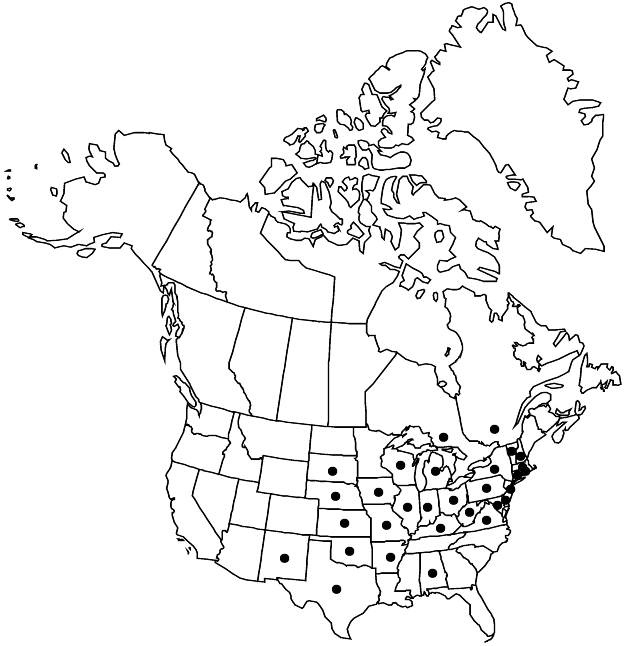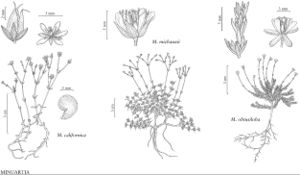Minuartia michauxii
Rep. (Annual) Michigan Acad. Sci. 20: 177. 1919.
Plants perennial, cespitose, sometimes matted. Taproots thickened, woody; crown many-branched, thickened. Stems erect to ascending, green, 8–40 cm, glabrous, internodes of flowering stems 0.5–10+ times as long as leaves. Leaves tightly overlapping in proximal 1/3 of stem, variable spaced, usually connate proximally, with loose, scarious sheath 0.2–1 mm; blade erect to spreading, green, flat or convex to 3-angled, 1–3-veined, prominently so abaxially, filiform, linear to linear-lanceolate, 8–30 × 0.5–1.8 mm, rigid, margins not thickened, ± scarious, smooth, apex green, blunt to pungent, flat to navicular, shiny, glabrous; axillary leaves present among vegetative leaves. Inflorescences 5–30-flowered, lax to congested cymes; bracts narrowly lanceolate to subulate, herbaceous, margins scarious. Pedicels 0.3–6 cm, glabrous. Flowers: hypanthium dish-shaped; sepals 3-veined, ovate to lanceolate (herbaceous portion ovate to narrowly lanceolate), 3–6 mm, not enlarging in fruit, apex green, acute to mostly acuminate, not hooded, glabrous; petals oblong-obovate, 1.3–2 times as long as sepals, apex rounded, entire. Capsules on stipe ca. 0.1–0.2 mm, ellipsoid, 3–4 mm, usually shorter than sepals. Seeds black, suborbiculate, compressed, 0.8–0.9 mm, tuberculate; tubercles elongate. 2n = 30(?), 44.
Phenology: Flowering spring–summer.
Habitat: Dry, calcareous gravel and ledges
Elevation: 0-1000 m
Distribution

Ont., Que., Ala., Ark., Conn., Del., Ill., Ind., Iowa, Kans., Ky., Md., Mass., Mich., Mo., Nebr., N.H., N.J., N.Mex., N.Y., Ohio, Okla., Pa., R.I., S.Dak., Tex., Vt., Va., W.Va., Wis.
Discussion
We concur with J. A. Steyermark (1963) and G. Yatskievych and J. Turner (1990) that the concept of Arenaria texana originally put forth by Britton requires further study. Plants labeled as Minuartia michauxii var. texana have slightly shorter leaves that are crowded into the proximal one-third rather than one-half of the somewhat shorter stem. The plants are often in the southern part of the range and may, as Steyermark noted, be associated with more open, xeric habitats.
Selected References
None.
